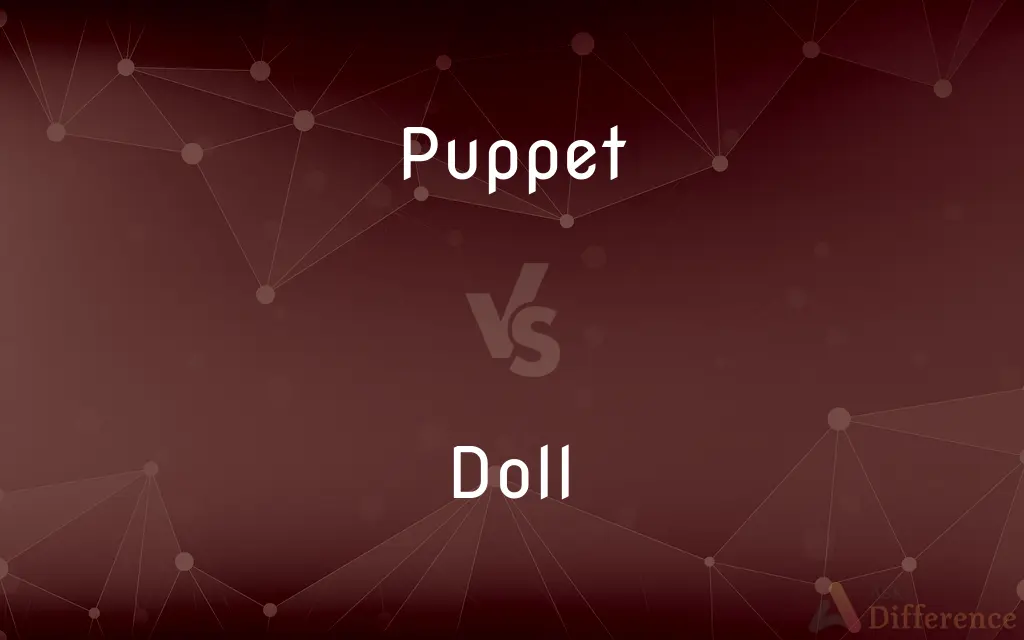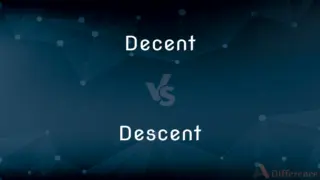Puppet vs. Doll — What's the Difference?
By Tayyaba Rehman & Maham Liaqat — Updated on April 3, 2024
Puppets are designed for manipulation to simulate motion or speech, often used in performances, while dolls are primarily static figures intended for play or display, with a focus on appearance.

Difference Between Puppet and Doll
Table of Contents
ADVERTISEMENT
Key Differences
Puppets are crafted with the intention of being animated, either by hand, strings, or rods, to create the illusion of life. They are essential tools in theatrical performances and storytelling, capable of intricate movements that mimic real-life gestures. Dolls, on the other hand, are typically designed for children's play or as collectibles, focusing on the aesthetics of human or mythical figures, offering less mobility but more detail in appearance.
While puppets are used in various forms of entertainment, including television, theater, and education, emphasizing interaction and performance, dolls are often personal belongings that encourage imaginative play, storytelling, and emotional attachment. This distinction highlights the puppet's role in public storytelling versus the doll's role in personal and developmental activities.
The materials used in puppet construction vary widely, from traditional wood and cloth to modern plastics and latex, chosen for durability and ease of manipulation. Dolls, conversely, are made from a wide range of materials including porcelain, cloth, and plastic, with a greater emphasis on tactile and visual appeal, reflecting trends in fashion and cultural aesthetics.
Puppets are distinguished by their diversity in form and function, including hand puppets, marionettes, and shadow puppets, each designed for specific types of performance. Dolls are categorized by their intended use, such as fashion dolls, action figures, and baby dolls, each reflecting different aspects of human life and fantasy.
The cultural significance of puppets extends beyond entertainment, serving as mediums for education, social commentary, and historical preservation. Dolls hold a mirror to societal values and changes, often used as historical documents that reflect the cultural and societal norms of their time.
ADVERTISEMENT
Comparison Chart
Primary Use
Animation for performance
Play or display
Interaction
Manipulated to simulate motion or speech
Primarily static, used for imaginative play
Material Emphasis
Durability and ease of manipulation
Visual and tactile appeal
Types
Hand puppets, marionettes, shadow puppets
Fashion dolls, action figures, baby dolls
Cultural Role
Medium for storytelling, education, commentary
Reflection of societal values and aesthetics
Compare with Definitions
Puppet
Reflects cultural and social themes through performance.
The puppet show addressed topics of environmental conservation.
Doll
Can be made from materials like cloth, porcelain, or plastic.
The handmade cloth dolls were popular at the craft fair.
Puppet
A figure moved by an individual to create performance art.
The puppeteer used a marionette to tell the story.
Doll
Reflects fashion trends and cultural values.
The fashion doll wore outfits from the latest runway shows.
Puppet
Can mimic lifelike gestures and expressions.
The skillful manipulation of the puppet made it seem alive.
Doll
Encourages imaginative play and storytelling.
Using dolls, the children created their own fantasy world.
Puppet
Often used in education and entertainment.
Educational puppets engaged the students in the lesson.
Doll
A figure representing a human or mythical being, used for play.
The child cherished her porcelain doll.
Puppet
Comes in various forms like marionettes and hand puppets.
The children were fascinated by the hand puppet show.
Doll
Serves as a toy or collectible with detailed features.
The collection included dolls from various historical periods.
Puppet
A puppet is an object, often resembling a human, animal or mythical figure, that is animated or manipulated by a person called a puppeteer. The puppeteer uses movements of their hands, arms, or control devices such as rods or strings to move the body, head, limbs, and in some cases the mouth and eyes of the puppet.
Doll
A doll is a model typically of a human or humanoid character, traditionally used as a toy for young girls. Dolls have also been used in religious rituals throughout the world.
Puppet
A small figure of a person or animal, having a cloth body and hollow head, designed to be fitted over and manipulated by the hand.
Doll
A small model of a human figure, typically one of a baby or girl, used as a child's toy.
Puppet
A figure having jointed parts animated from above by strings or wires; a marionette.
Doll
A temporary barrier on a racecourse or gallop.
Puppet
A toy representing a human figure; a doll.
Doll
Dress someone smartly and attractively
I got all dolled up for a party
Puppet
One whose behavior is determined by the will of others
A political puppet.
Doll
Place a barrier in front of (a jump or other part of the course that is to be omitted from a race)
Staff incorrectly dolled off a fence at the meeting
Puppet
Any small model of a person or animal able to be moved by strings or rods, or in the form of a glove.
Doll
A figure having the likeness of a human, especially one used as a child's toy.
Puppet
(figuratively) A person, country, etc, controlled by another.
Doll
A person considered to be physically attractive.
Puppet
(obsolete) A poppet; a small image in the human form; a doll.
Doll
A woman.
Puppet
(engineering) The upright support for the bearing of the spindle in a lathe.
Doll
A helpful or obliging person
What a doll you've been in this crisis!.
Puppet
A small image in the human form; a doll.
Doll
Used as a term of endearment.
Puppet
A similar figure moved by the hand or by a wire in a mock drama; a marionette; a wooden actor in a play.
At the pipes of some carved organ move,The gilded puppets dance.
Doll
A toy in the form of a human.
Action figure
Puppet
One controlled in his action by the will of another; a tool; - so used in contempt.
Doll
(slang) An attractive young woman.
Puppet
The upright support for the bearing of the spindle in a lathe.
Doll
A term of endearment: darling, sweetheart.
Puppet
A small figure of a person operated from above with strings by a puppeteer
Doll
A good-natured, cooperative or helpful girl.
Puppet
A person who is controlled by others and is used to perform unpleasant or dishonest tasks for someone else
Doll
The smallest or pet pig in a litter.
Puppet
A doll with a hollow head of a person or animal and a cloth body; intended to fit over the hand and be manipulated with the fingers
Doll
A kind of barrier used in horse racing.
Doll
(rail) A short signal post mounted on a bracket mounted on the main signal post, or on a signal gantry.
Doll
A dollar.
Doll
A small, usually flexible figure representing a human being, especially a toy baby for a little girl; a child's puppet.
Doll
An attractive woman or girl.
Come along and be my party doll.
Doll
A small replica of a person; used as a toy
Doll
Informal terms for a (young) woman
Common Curiosities
What is the main difference between a puppet and a doll?
The main difference lies in their use; puppets are for performance and animation, while dolls are for play or display.
Do puppets have educational purposes?
Yes, puppets are often used in educational settings to facilitate learning and engagement through storytelling and interaction.
How are puppets made?
Puppets are crafted from materials like cloth, wood, and plastic, designed for ease of manipulation and durability in performance.
Can a doll be used as a puppet?
While not designed for it, some dolls can be adapted for puppet-like play, but they lack the specific features for animation.
Why do children play with dolls?
Dolls encourage imaginative play, emotional expression, and social skills development among children.
How do cultural differences influence puppet designs?
Puppet designs are deeply influenced by cultural heritage, mythology, and storytelling traditions, varying significantly around the world.
How has the purpose of dolls changed over time?
While play has always been a primary purpose, dolls have evolved to include educational roles and social commentary, reflecting changing societal norms.
Can dolls be considered art?
Yes, dolls can be highly artistic, especially collectible and handmade dolls, reflecting craftsmanship and cultural significance.
What role do dolls play in cultural traditions?
Dolls can have ceremonial and educational roles in cultural traditions, often used to teach social values and history.
Are puppets always controlled by strings?
No, puppets can be controlled by strings, hands, rods, or other mechanisms, depending on their type.
What types of stories do puppets tell?
Puppets can tell a wide range of stories, from traditional folktales to modern narratives, often with educational or moral themes.
Is puppetry considered a form of art?
Absolutely, puppetry is a sophisticated form of performing arts, requiring skill in construction, manipulation, and storytelling.
Are all dolls intended for children?
No, many dolls are collectibles aimed at adults, valued for their craftsmanship, historical significance, and aesthetic appeal.
Can puppets and dolls be considered similar?
While they share similarities as representational figures, their primary functions of animation versus play distinguish them.
What innovations have impacted the development of puppets and dolls?
Technological advances in materials and manufacturing have expanded the possibilities for both puppets and dolls, enhancing their realism and versatility.
Share Your Discovery

Previous Comparison
Decent vs. Descent
Next Comparison
Breath vs. BreatheAuthor Spotlight
Written by
Tayyaba RehmanTayyaba Rehman is a distinguished writer, currently serving as a primary contributor to askdifference.com. As a researcher in semantics and etymology, Tayyaba's passion for the complexity of languages and their distinctions has found a perfect home on the platform. Tayyaba delves into the intricacies of language, distinguishing between commonly confused words and phrases, thereby providing clarity for readers worldwide.
Co-written by
Maham Liaqat














































